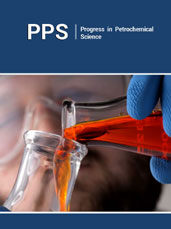- Submissions

Abstract
Progress in Petrochemical Science
Liquefied Petroleum Gas: A Comprehensive Review of Its Manufacturing and Refining Routes
-
Open or CloseVipin Kumar Sharma1,2*, Sunil Kumar Thamida1, Bhumireddy Naveen Kumar Reddy2 and Manjay Kumar1
1Department of Chemical Engineering, Indian Institute of Technology, India
2Uranium Corporation of India Limited, India
*Corresponding author:Ehime Itamah, Department of Chemical Engineering, Ahmadu Bello University, Zaria, Nigeria
Submission: April 10, 2025; Published: May 14, 2025

ISSN 2637-8035Volume7 Issue 2
Abstract
Liquefied Petroleum Gas (LPG) is a clean-burning, high-energy fuel that plays a vital role in energy systems across residential, commercial, and industrial sectors globally. This paper offers an extensive review of the diverse manufacturing and refining methods involved in LPG production, emphasizing both traditional and innovative technologies. LPG is mainly produced as a by-product of natural gas processing and petroleum refining. The review delves into essential processes such as crude oil distillation, catalytic cracking, and hydro processing, which are crucial for the separation and enhancement of propane and butane, the primary constituents of LPG. Furthermore, the paper examines the incorporation of gas recovery systems in upstream natural gas operations and the significance of fractionation units in maintaining the purity and safety of the final LPG product. It also addresses strategies for process optimization aimed at improving yield and energy efficiency, alongside environmental considerations linked to LPG production. Given the rising demand for low-emission fuels, the potential for producing bio-LPG from renewable resources is briefly discussed as a promising alternative. Data analysis was conducted using advanced Python programming, with predictive results generated accordingly. The study also sheds light on global production trends, regional differences in refining technologies, and the challenges related to storage, transportation, and regulatory compliance. Ultimately, this review aspires to be a valuable resource for engineers, researchers, and policymakers who wish to comprehend the technological framework of LPG manufacturing while pinpointing opportunities for innovation and enhancement considering changing energy needs and sustainability objectives.
Keywords:LPG production; Natural gas processing; Petroleum refining; Hydrocarbon separation; Process optimization; Bio-LPG
Abbreviations: BPCL: Bharat Petroleum Corporation Limited; C₂H₄: Ethylene; C₃H₆: Propylene; C₃H₈: Propane; C₄H₁₀: Butane; CAGR: Compound Annual Growth Rate; CₙHₘ: General formula for Hydrocarbons (where n and m are integers); CO: Carbon Monoxide; CO₂: Carbon Dioxide; FCC: Fluid Catalytic Cracking; GAIL: Gas Authority of India Limited; HPCL: Hindustan Petroleum Corporation Limited; HYSYS: Hyprotech Systems (Process Simulation Software by AspenTech); IOCL: Indian Oil Corporation Limited; LPG: Liquefied Petroleum Gas; MT: Metric Tons; NaOH: Sodium Hydroxide; R-SH: Generic formula for Mercaptans (Thiols); RIL: Reliance Industries Limited; rLPG: Renewable Liquefied Petroleum Gas; RSH: Mercaptan (another form of R-SH); RSSR: Disulfides (Result from Oxidation of Mercaptans); TPA: Tonnes Per Annum; UOP: Universal Oil Products (now Honeywell UOP); USA: United States of America; USD: United States Dollar
 a Creative Commons Attribution 4.0 International License. Based on a work at www.crimsonpublishers.com.
Best viewed in
a Creative Commons Attribution 4.0 International License. Based on a work at www.crimsonpublishers.com.
Best viewed in 







.jpg)






























 Editorial Board Registrations
Editorial Board Registrations Submit your Article
Submit your Article Refer a Friend
Refer a Friend Advertise With Us
Advertise With Us
.jpg)






.jpg)














.bmp)
.jpg)
.png)
.jpg)










.jpg)






.png)

.png)



.png)






